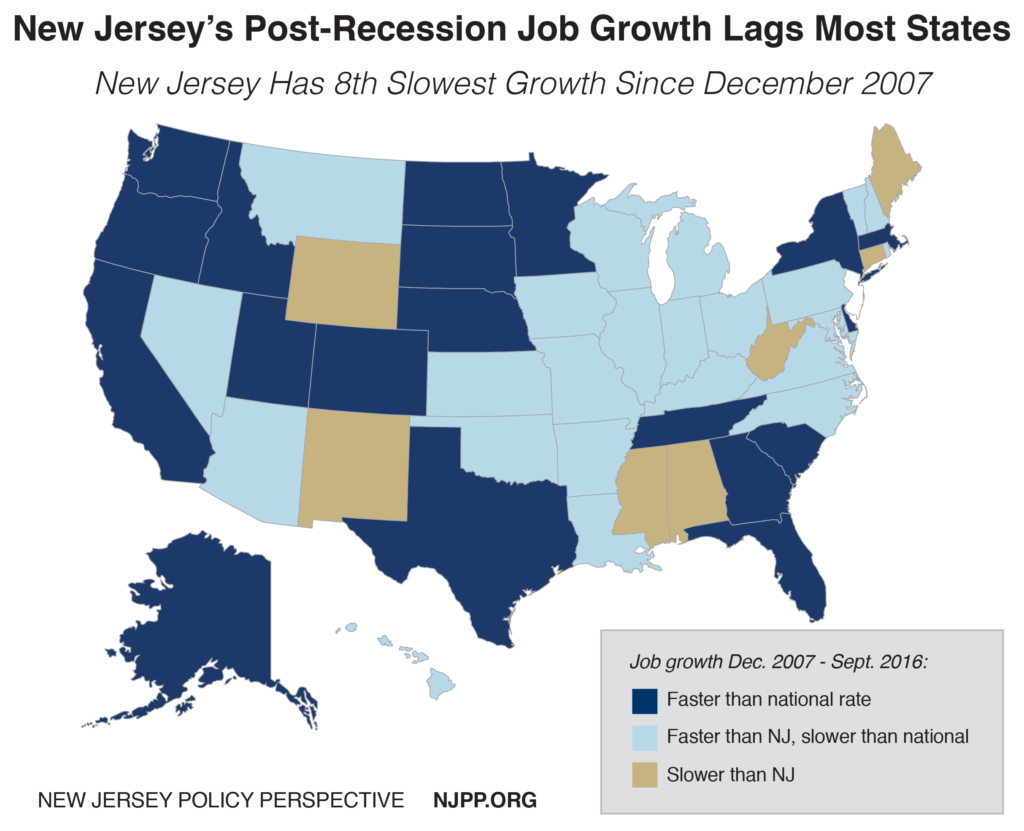These prepared remarks were delivered to the Senate Legislative Oversight Committee on September 29, 2016.
Chairman Gordon and members of the committee, thank you for inviting me to speak about the adequacy – or inadequacy – of New Jersey’s Temporary Assistance for Needy Families program, which is supposed to be the safety net of last resort for some of the state’s poorest families with kids.
There are some essential facts about TANF – and New Jersey’s support of the families this assistance is designed to serve – that are crystal clear, and quite distressing. In short, this safety net of last resort is failing thousands of the state’s poorest children and families. And that failure is a major contributor to a stubborn crisis in New Jersey, with child poverty in 2015 34 percent higher than it was in 2007, before the Great Recession.
But let’s all start by going even further back in time, to 1987. What was going on in your life? How much have things changed since then? I’m pretty sure we’d all say quite a lot has changed. What hasn’t changed, sadly, is New Jersey’s cash assistance for TANF families. It’s been completely stagnant since 1987. No adjustments for inflation, no accounting for the state’s high cost of living. Nothing.
So what does 29 years of inaction do to the program’s adequacy? It absolutely decimates it. The maximum TANF assistance for a family of three is $424 a month, the same level it was in 1987. But its real value has been cut in half due to inflation, and today it only gets a struggling family to 25 percent of the federal poverty level, which itself is an inadequate measure of what it truly takes to get by in this state.
At this level, New Jersey’s TANF assistance is the lowest in the Northeast by far. New York’s assistance, for example, is nearly double ours. And when you factor in the high cost of housing in New Jersey, 40 states – including places like West Virginia and Kentucky – offer stronger support to families receiving TANF.
But when it comes to the inadequacy of TANF, don’t just take our word for it. The state itself acknowledges that this assistance comes nowhere near what it takes to support a struggling family. Since 2003, the Department of Human Services has established a standard for decency that takes into account real needs of a family including the cost of housing. That standard is now $2,700 per month for a family of three, seven times higher then current TANF assistance.
While dwindling state support of TANF has a clear effect on the families that receive this crucial assistance – they are getting the same amount even as everything costs more – it has a more profound, but less visible, effect on the countless families and kids who do not receive TANF. And, sadly, more and more of the state’s poorest families are falling into this category.
That’s because a family’s eligibility for TANF is based on the benefit level. Families earning more than 150 percent of the benefit level are not eligible for assistance. For a family of three, that means that if you earn more than $636 a month – or about $7,600 a year – you are cut off from assistance. It’s beyond debate that a family earning $10,000 is still in deep, deep poverty in New Jersey. Yet this family currently receives no TANF assistance.
As a result, the number of New Jerseyans enrolled in TANF has plunged since the last time the assistance level was increased. In 1988, over 300,000 residents were enrolled in TANF. By 2015, that number dropped to under 60,000 – an 81 percent decrease.
And because TANF serves families with kids, children are the ones that are ultimately harmed. In fact, 82% of New Jersey’s poor children don’t receive any assistance. That’s more than a quarter-million New Jersey kids we’re talking about.
The low level of assistance and other restrictions have also made TANF unresponsive to real needs in our state. While there have been major increases in unemployment and the child poverty rate, the TANF enrollment rate has gone down substantially – exactly the opposite of what you would expect. In fact, over the same time that TANF enrollment has dropped by 81 percent, New Jersey’s unemployment rate has risen by 78 percent.
And it’s not just temporary cash assistance these poor families are missing out on. The state offers a broad array of important other services in TANF designed to promote economic independence, like education and training programs, and support services like child care and transportation. But for families struggling to find a foothold, these services are only worthwhile if they can be accessed. And today in New Jersey, most parents below the poverty level are not eligible for any of these supports because, like most poor kids, they are not eligible for TANF.
In fact, in the last two years alone, the number of families receiving education and training services through TANF has dropped by 46 percent, while the number receiving emergency assistance has declined by a stunning 58 percent (to 2,766 from 6,625 families).
To reverse course and begin shoring up this safety net of last resort, New Jersey needs to start by increasing assistance levels. The proposal we supported this spring, which passed the Senate and Assembly with bipartisan support, thanks to the efforts of co-sponsors like Senator Ruiz on this panel, would have increased the assistance level by 30 percent over three years, rising to $551 for a family of three. After that modest but crucial bump, the assistance level would’ve been tied to inflation to help ensure that these families don’t continue to fall even further behind in the future. While the bill was vetoed by the governor, we urge all of you not to forget about these families and these children, and to continue to make improving TANF’s adequacy a priority.
 In the midst of the closely-watched presidential election, it is important to remember that New Jersey’s two ballot measures deserve close attention. Question 1 would authorize casino expansion to North Jersey, while Question 2 would constitutionally dedicate all fuel taxes to capital improvements to transportation networks. The first should be defeated; the second approved.
In the midst of the closely-watched presidential election, it is important to remember that New Jersey’s two ballot measures deserve close attention. Question 1 would authorize casino expansion to North Jersey, while Question 2 would constitutionally dedicate all fuel taxes to capital improvements to transportation networks. The first should be defeated; the second approved.







